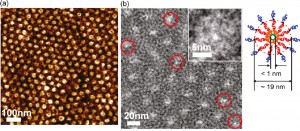Polymeric membranes with nanometer-sized channels could be used in a variety of important applications, such as devices for capturing greenhouse gases, production of solar radiation-based fuels, and desalination of seawater. In order to achieve these applications, it will be necessary to develop a method for producing such membranes on a commercial scale. Researchers have now succeeded in advancing the field through the development of an innovative method.

Researchers from the National Laboratory of the US Department of Energy and the University of California (Berkeley) have succeeded in developing a new method that can be used to initiate the self-assembly of flexible polymeric membranes with highly ordered sub-nanometer channels. This innovative method, which is fully compatible with existing commercial membrane production processes, is a first example of the production of organic nanotubes embedded in a functional membrane over macroscopic distances.
"We used nanotube-forming ring peptides and block copolymers to demonstrate a direct co-assembly method for preparing membranes with sub-nanometer pores," said principal investigator Ting Xu.
"This innovative method will allow us to prepare thin porous layers in the future whose shape and size we can determine in advance by the molecular structure of the organic nanotubes." The research findings were published in the scientific journal DHW Nano.
Membranes with channels are one of the most important and sophisticated inventions created by nature. Membranes containing sub-nanometer channels serve as a boundary between the substances found inside the biological cell and the substances found outside it - mainly depending on their size - and are responsible for the transport of molecules and vital substances into, through and outside the cell. In this approach lies great potential for the development of a wide variety of important technologies, however the greatest challenge in the field has so far been finding cost-effective means for an organized arrangement of sub-nanometer channels along macroscopic distances by means of flexible substrates.
"Achieving molecular level control over the size and shape of the nozzles, as well as over the surface chemistry of channels in polymeric membranes has been tested in many areas of research, but still remains a significant bottleneck," explains the researcher. "Layers of composite materials have already been prepared using hollow carbon nanotubes and there is rapid progress in the field. However, there is still a challenge in controlling the appropriate arrangement of these nanotubes over large distances." In their research, the scientists used organic nanotubes that are naturally formed by cyclic peptides, and which, unlike other types, can be changed in size and spatial arrangement during the production itself. In order to prepare the membrane itself, the researchers used long chains of monomer molecules of one type linked to chains of another type (block copolymer). Just as cyclic peptides self-assemble into nanotubes, so do polymers self-assemble into long-range ordered arrays of nanostructures.
A polymer that was chemically linked to the ring peptide was used as a "mediator" connecting these two distinct systems that organize independently.
"The intermediary polymer is the key to success," explains the researcher. "It controls the interface between the ring peptides and the polymers and coordinates their self-organization. The result is that nanotube type channels are obtained only within the polymer skeleton in the membrane.
The researchers were able to produce porous membranes with sub-nanometer-sized holes that span several centimeters and which are characterized by extremely dense arrays of channels. The canals were tested by measuring the passage of carbon dioxide and neo-pentane gases. The measurements confirmed that the permeability was higher for the smaller carbon dioxide molecules than the larger neo-pentane molecules. The researchers' next step will be to exploit this method to make thinner membranes.

2 תגובות
Where can you buy molecular polymer sheets for filtering gray water?
Cool, we're making progress!